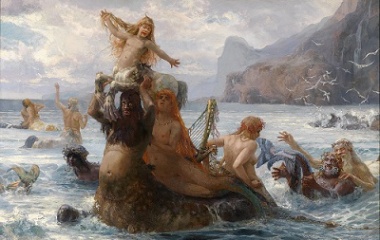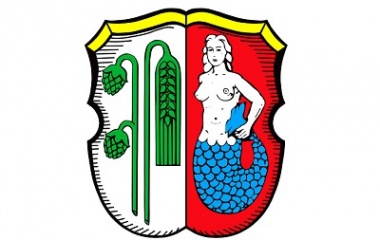What Is Nix?
Nix (singular: Neck; feminine: Nixie) are spirits who dwell in quiet rivers and lakes in England, Germany, and Scandinavia. Their love of water is equaled only by their love of music, and their beautiful songs often draw listeners to the banks of their watery homes.
Characteristics
Physical Description
Each culture has its own take on the Nix’s appearance, and the creatures themselves can’t seem to settle on one appearance either. They are avid shapeshifters and may appear as humans, merpeople, snakes, fish, sunken treasures, or horses.
In human form, they usually have an elegant appearance, although their features might hint at their wilder natures. Their ears and eyes are sharper than usual, and their hair and skin might be tinted with green or blue. In more extreme cases, they can have gills, bulbous eyes, and webbed hands and feet. Their garments, though stylish, are chronically wet around the hems.
When they take the form of horses, they are pure white or apple-grey. Though they are far more beautiful than average horses, they still bear telltale signs of their true nature, having manes full of river weeds or constantly dripping water.
Special Abilities
Nix are magical beings; there’s no limit to the hijinks they have committed across the many folktales in which they appear. Still, some of their abilities emerge as common themes.
These water spirits are shapeshifters. Seemingly, they can take on any appearance they want.
Their musical talent is beyond comparison. All of them sing sweetly, and some of them couple musical instruments with their already spellbinding voices. Their music is capable of hypnotizing listeners and drawing them into the water. Generally, Nix have more power over women and children, while the feminine Nixie entrance grown men.
When they’re in an animal form, Nix replace the charms of their music with dazzling physical beauty. As horses, they can hypnotize onlookers by prancing around, flaunting their manes and tails, as easily as they can when singing in a human form.
Weaknesses
Nix are magical, but they’re not invincible. There are several ways you can take on one of these water spirits, if it becomes problematic.
Early legends hold that dropping a piece of silver or iron into a Neck’s home can silence it while you safely cross the water. Shouting the creature’s name, on the other hand, can silence it forever. The Neck will perish at the sound of its own name.
When Nix appear as horses, they’re often subjected to tricks by local farmers, who want to harness their magical powers to a plow. A Neck might be lured into the field by a beautiful maiden, then forced into the plow’s harness by men with silver or iron.
The creatures can’t bear separation from water for a great length of time. If they don’t return to water regularly, their spirits and powers will become depressed. Eventually, they might perish from longing for their river or lake.
After Catholicism gripped Western Europe, many of the traditional folktales were adapted to show the power of the church. At this time, it was said that you could ward the creatures off with holy water or by making the sign of the cross.
Personality
In some tales, Nix appear as dangerous villains. In others, they are wise teachers, and in others still, they are romantic figures.
When Nix take a villainous bent, they usually have seductive qualities. With music or beauty, they lure humans closer and closer to the water’s edge. At last, they grab their victims and drown them in the water.
When they accept humans as students instead of victims, they can impart wonderful musical abilities. Usually, they require payment for their lessons. A black animal, a gift of alcohol or tobacco, or a beautiful maiden can buy a Neck’s time.
At the onset of the Romantic Era, Nix emerged as potential lovers for human beings. Both Nix and Nixie can fall in love with humans. When they do, the humans can rarely resist returning their feelings. After all, these magical water spirits are both beautiful and spectacular at serenading their lovers. Most Nix-human relationships come to a bittersweet end, however. The Neck or Nixie can’t bear separation from its watery home and returns to life there, despite being deeply devoted to its human partner.
Eventually, after Catholicism took hold, the Nix personality was deepened by their desire for Christian redemption and an immortal soul. Their music was said to bemoan the fact that they were shut out of the church, and many people who encountered the mournful spirits were afflicted with heart-rending pity.
Famous Nix Characters
On top of the widespread fame that their race enjoys, some representatives of Nix mythology have a special fame all of their own.
The Fossegrim (Strömkalen) belongs to Norwegian and Swedish mythology. He usually dwells near waterfalls or mills, where he plays gorgeous melodies on a violin. In exchange for the right gift, he will teach humans how to play the violin so that the birds, the trees, and even the blind, deaf, and lame will dance.
The Brook Horse (Bäckahästen) belongs to Scandinavian mythology. He appears as an ethereal white horse near rivers, usually during foggy weather. People are attracted to the white glow of his skin like moths are to light, but if they climb onto the Brook Horse, they will find themselves trapped on his back. The horse then gallops back to the river and drowns his rider.
Related Characters
Some water spirits, outside of the Nix race, might have been influential in the development of this creature’s mythology.
Kelpies, coming from Scandinavian culture, are definitely related to the Nix. Both are water creatures, and both frequently appear on land as horses, with the intent of luring humans into the water and drowning them. In contrast to Nix, Kelpies usually appear as monstrous black horses.
Grindylows, belonging to English folklore, are likely to be related to Nix. Like Nix, they are dangerous aquatic creatures who grab and drown humans when they venture within reach. Unlike Nix, Grindylows commonly inhabit bogs and marshes, and they have no association with music.
Nymphs, belonging to Greek and Latin mythology, might have tinged Nix mythology after Greek culture took root in Germany and Scandinavia. Like Nix, nymphs are associated with nature, sometimes with water. They are beautiful in appearance and often produce sweet music. Unlike Nix, nymphs are gentle and helpful spirits with no reputation for violence. If nymphs did influence Nix mythology, the influence is probably seen in some of the later legends about Nix, when the creatures were more prone to becoming romantically entangled with humans.
Cultural Representation
Origin
Nix come from Germanic, Northern European cultures, where oral tradition goes back much, much further than the written record. For this reason, it’s difficult to trace exactly how they split off from other water spirits and became their own, recognized creature. Certainly, the split occurred before 1210, when Nix were mentioned in a German epic poem, Nibelungenlied.
The word Nix comes from Old German and has undergone many variations (German: Nichus, Niches, Nix; Dutch: nikker, nekker; Norwegian: nøkk; Swedish: näck; Finnish: näkki; Estonian:näkk) as it spread across cultures and as the ancient languages evolved into their modern style. The original meaning of the name is “to wash or bathe.”
Literature and Visual Arts
Nix appear in some of Northern Europe’s earliest epic poems. Some scholars even categorize the river monster in Beowulf, the oldest epic poem written in the English language, as a Neck.
Among other magical creatures from folklore, the Romantic Era ushered Nix onto the canvases of many great painters and onto the stages of many great theaters. Richard Wagner’s opera, Der Ring des Nibelungen, famously featured the Rhinemaidens, a trio of Nixies who protected a golden treasure in the Rhine river. Meanwhile, Heinrich Heine and Friedrich Silcher teamed up to create one of Germany’s most beloved folk songs about a Nixie name Lorelei.
Around the same period, Jakob Grimm, one of the most famous fairytale writers of all time, discussed Nix in his book Deutsh Mythologie, which catalogued the most important creatures from German folktales. Grimm grouped them with other water sprites who enjoy singing and dancing and likened them to the sirens of classical mythology, who drew men into treacherous waters with their hypnotic voices.
Today, Nix appear in many role-playing games and video games. They are usually humanoid and often have magical abilities related to water.
Explanation of the Myth
Water, which is both essential to life and dangerously treacherous, has always captivated the human imagination, and stories of spirits inhabiting the water exist in every culture on earth. To some degree, belief in water spirits, like the Nix, might be an early way in which humans expressed their awareness of the power of water.
Later incarnations of the Nix might have served a more defined purpose. They could be cautionary figures, used by parents to keep their children from venturing too close to a hazardous area of a river or too near the shores of a lake on a foggy night.










